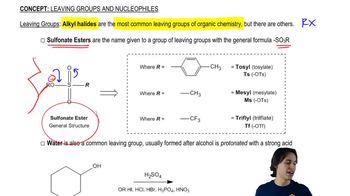(a) Show how you would affect the following transformation using a tosylate.
(b) Why might this not be the most sustainable method?
(c) What reagent might you use instead?
 Verified step by step guidance
Verified step by step guidance Verified video answer for a similar problem:
Verified video answer for a similar problem:



 7:53m
7:53mMaster Learning the mechanism of Sulfonyl Chlorides. with a bite sized video explanation from Johnny
Start learning